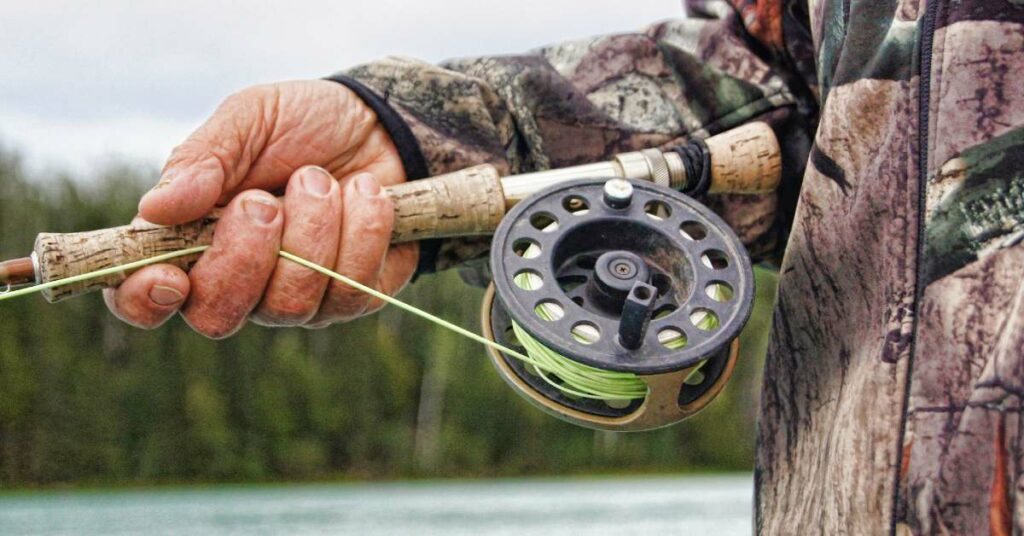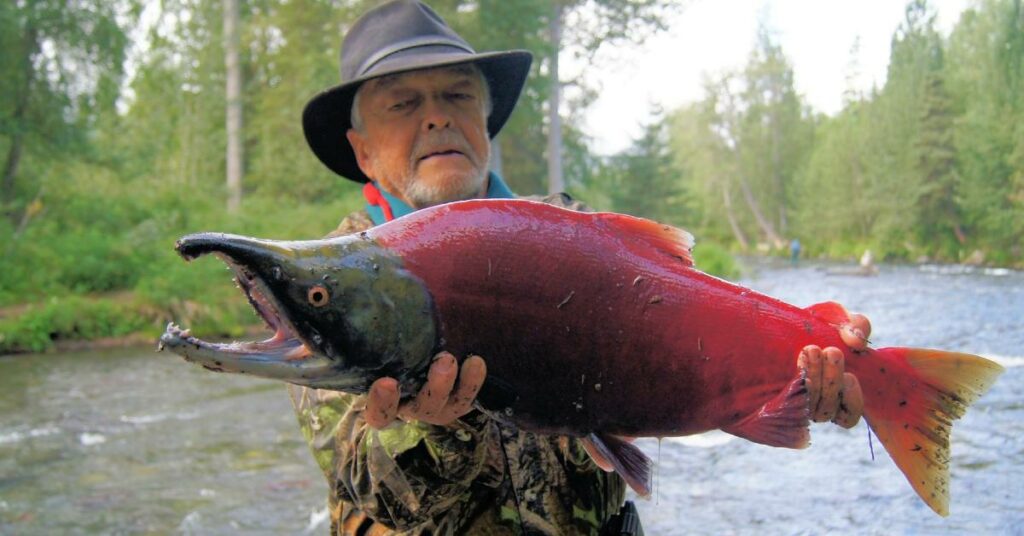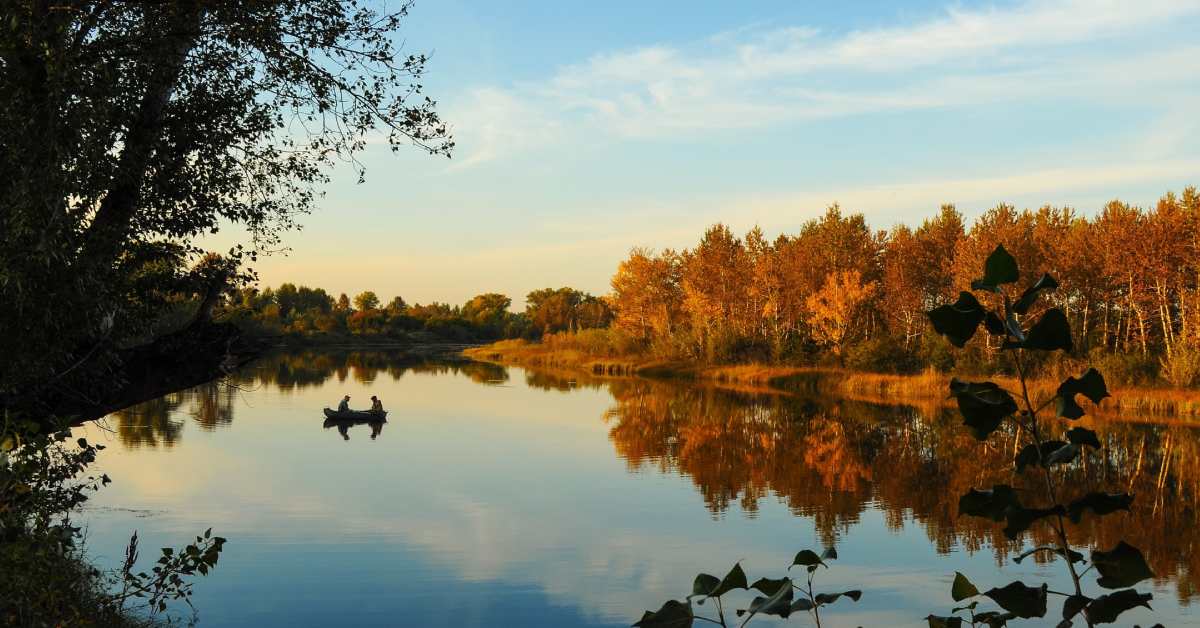Salmon Facts is thrilled to join forces with the Atlantic Salmon Federation, an international authority on the topic of the ecology and conservation of river salmon fishing in North America.
Their former website, atlanticsalmonfederation.org, promoted their commitment to returning Wild Atlantic Salmon to historic levels, working wherever there are Atlantic salmon in North America, out at sea, and internationally. Their mission is supported by a dedicated membership of anglers, nature lovers, students and the environmentally concerned.
How to Fish for Salmon in a River
Fishing for salmon in river systems can be a thrilling and rewarding experience for anglers of all levels. However, it requires the right gear, techniques, and local knowledge to increase the chances of a successful catch.
Salmon runs occur at different times of the year, depending on the species and location. In general, the fall season is the best time for salmon fishing in most rivers of the U.S. and Canada. During this time, salmon migrate from the ocean to spawn in rivers, offering anglers a greater chance to catch them.
As for locations, salmon tend to congregate in areas with deep pools and fast currents. Look for areas with a lot of structure such as boulders, logs, and undercut banks, as salmon tend to seek shelter in those areas. It is also worth researching the specific river and area you plan to fish, as different rivers may have different salmon runs and seasonal patterns. See our guide on the top 10 destinations for Salmon fishing.
Best Setup for Salmon River Fishing
The right salmon river fishing gear is crucial when it comes to salmon fishing. Some essential items to consider include:
- Rod and reel: A medium to heavy-duty rod and reel combo that can handle the weight and fight of a salmon is necessary. Look for rods that are at least 9 feet long with a fast action.
- Line and leader: A quality fishing line with a high breaking strength is important. Fluorocarbon leaders can be used for their invisibility and abrasion resistance.
- Hooks: Barbless hooks are required in some areas to minimize harm to the fish. Make sure to check the regulations for the specific river you plan to fish.
- Bait and lures: Salmon can be caught on a variety of baits and lures. Some popular salmon baits include salmon roe, herring, and shrimp. Lures such as spinners, spoons, and jigs can also be effective.
- Waders and boots: When fishing in rivers, it is important to stay dry and comfortable. Waders and boots can provide protection from the water and traction on slippery surfaces.
Successful salmon fishing requires more than just the right gear. Proper technique can make a big difference in catching a salmon. Practice casting and retrieving until you feel comfortable with the motion. Be sure to experiment with different types of bait and lures to see what works best in the specific river you are fishing.

River fishing for salmon also requires a great deal of patience and persistence. Be prepared to spend several hours in one spot, waiting for the fish to bite. Look for areas where the water is moving faster or slower than the surrounding areas. These areas can indicate where the fish may be located.
Above all, respect the fish. Salmon are a valuable resource that should be respected. Handle them gently, release them quickly and unharmed, and follow the local fishing regulations to ensure their protection.
Conservation of River Salmon and Their Habitats
Conservation efforts for salmon populations are critical to ensure the long-term sustainability of the species. While recreational fishing can be a valuable activity for individuals and communities, it is essential to practice responsible and ethical fishing practices to protect the species.
In this section, we will cover the importance of conservation efforts for salmon populations, the threats to salmon populations, and efforts to protect and restore salmon populations in river fishing contexts.
Salmon play a crucial role in the freshwater and marine ecosystems they inhabit. They are a source of food for a wide range of wildlife, and their nutrient-rich carcasses provide important nutrients to the environment.
The loss of salmon populations can have a detrimental effect on the health of the ecosystems they inhabit, as well as on the economies and cultures of the regions that rely on them.
In addition, river salmon populations face many threats, including overfishing, habitat loss, pollution, and climate change. Without conservation efforts, salmon populations could decline to the point of extinction, with significant ecological and economic consequences.
Salmon populations face a variety of threats that can impact their survival. Some of the most significant threats include:
- Overfishing: Overfishing can deplete salmon populations and disrupt their reproductive cycles, leading to a decline in their overall numbers.
- Habitat loss: Destruction and degradation of salmon habitats, such as riverbank development and dam construction, can limit their ability to spawn and migrate.
- Pollution: Pollution from human activities, such as industrial and agricultural runoff, can contaminate salmon habitats and impact their health.
- Climate change: Climate change can affect salmon populations in several ways, including altering water temperatures, water levels, and ocean currents, which can impact their migration patterns and food sources.
Efforts to protect and restore salmon populations To protect and restore salmon populations, a variety of conservation efforts are underway, including efforts to restore and protect salmon habitats, such as removing dams and replanting riverbanks, can help restore populations.
Fishing regulations, such as size limits and catch quotas, can help prevent overfishing and protect salmon populations. Additionally, the need for pollution control to limit the impact of human activities on salmon habitats can help ensure their survival.
Actions to mitigate the impacts of climate change, such as reducing greenhouse gas emissions and adapting to changing conditions, can help protect salmon populations in the long term.
By supporting these conservation efforts and practicing responsible and ethical fishing practices, anglers can contribute to the protection and restoration of salmon populations in rivers of the U.S. and Canada.
Preservation of Wild Atlantic Salmon
The Atlantic Salmon has for centuries been named the king of fish for its power and grace, and they are an important part of rural economies along the rivers where it spawns. There is a rich, vibrant culture surrounding the Atlantic salmon, its rivers, and its biology.
With your support and that of other conservationists, we are unraveling the mysteries of Atlantic salmon migration and mortality at sea, so that it will be possible to achieve these goals in the years ahead.
To achieve these goals, there needs to be a focus on the following issues.
Salmon Aquaculture
Salmon farming has grown to more than 1.2 Million tons per year in the countries around the North Atlantic and has proven to cause significant harm to wild Atlantic salmon runs on both sides of the Atlantic, in North America, as well as Europe and England. There are organizations working to reduce the impacts through pioneering efforts in land-based salmon farming; conducting scientific research to explore and document the impacts of aquaculture; encouraging the industry and government to take greater precautions, and advocating for more transparency in reporting escapes.
Low Marine Survival of Salmon
Unraveling the mystery of increased salmon mortality at sea requires fastidious tracking. With more than two decades of research, we are discovering particular stages of the migration cycle when mortalities occur.
Arrays of sonic receivers as far north as Labrador are equipped with satellite tags to find more about their movements and the conditions they are experiencing. There have been encouraging signs over the past few years that the large salmon traveling to and from ocean feeding grounds near Greenland are doing better, overall.
Recreational River Salmon Fisheries
Recreational anglers are an important part of this overall effort. When on the rivers, they are an effective “observation” force, reducing poaching and maintaining a high interest in having the rivers healthy and productive.
We actively encourage anglers to learn the techniques of live release and to practice them at all times. Wild Atlantic salmon are important to those who fish, and to the citizens who do not, but who understand the true value of this species.

Healthy freshwater conditions, and successful migration to and from the ocean, are absolutely essential to the survival of wild Atlantic salmon and a return to historic high levels. These rivers need to be well oxygenated, have cool water and sufficient food for young salmon, and we need to protect them from the presence of invasive species predators such as smallmouth bass and pickerel.
There needs to be sufficient protection against poachers, and residents who understand the importance of wild Atlantic salmon to the environment. An important part of keeping these rivers healthy is having a large number of conservation-minded anglers on the water, watching for illegal activity, and themselves practicing live release angling.
Dams and Fish Passage
It is important to understand the impact of dams and downstream fish passage on Atlantic salmon rivers. In Maine, three dams were purchased in order to decommission two and to provide a state of the art fishway around the third. In exchange the power company has moved power generation to other dams and there is no loss of input.
In Newfoundland and Quebec, they have developed various proposals for hydro development. On the St. Croix boundary river between Maine and New Brunswick, officials are working to have Maine unblock fishways to alewives, a native species.
Watershed Habitat and Water Quality
Various Regional Councils are extremely active in undertaking projects to safeguard freshwater ecosystems and to restore rivers. In Maine, this has included promoting new fishways; in Nova Scotia, pioneering a watershed liming project; in Newfoundland, promoting better forestry practices. In total, dozens of projects are being undertaken.
Endangered Species Status of Salmon
In both Canada and the United States, some populations of wild Atlantic salmon have been declared endangered. In Maine, this includes the Penobscot, which continues to have the single best chance of a healthy U.S. population of Atlantic salmon in the years ahead.
In Canada, the populations in the Bay of Fundy, plus those on the open-ocean side of Nova Scotia (acid rain-impacted), are at critically low levels and need assistance.
River Salmon Has Economic Importance
A recent study determined that the river salmon fishing industry was vitally important to the rural areas in which it occurred. The economic impact of salmon fisheries cannot be underestimated. Among the important facts:
- Value of wild Atlantic salmon on the open market was $455 Million
- Anglers spent $318 Million on river salmon sporting activities
- Overall value to river salmon regions in GDP was $150 Million
River Fishing for Salmon
Fishing for salmon in the rivers of the U.S. and Canada can be an enjoyable and rewarding experience for anglers. However, it is essential to practice responsible and ethical fishing practices to protect and conserve salmon populations.
To ensure the long-term sustainability of the species, conservation efforts such as habitat restoration, fishing regulations, pollution control, and climate change mitigation are critical. By supporting these conservation efforts and practicing responsible fishing practices, anglers can contribute to the protection and restoration of salmon populations in river fishing contexts.
It is crucial to remember that the conservation of salmon populations not only benefits the species but also has significant ecological and economic impacts on the regions that rely on them.


Wow! This is realy awesome. Before i did not know that. Thank you so much
for sharing this.